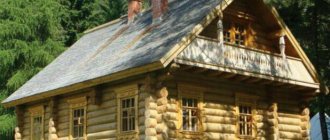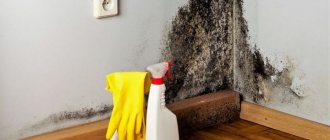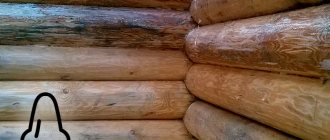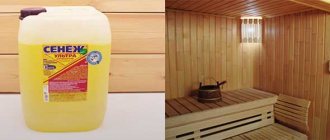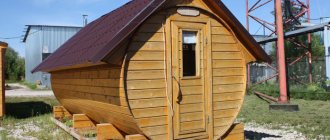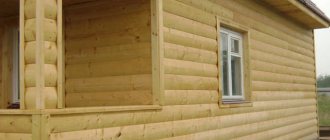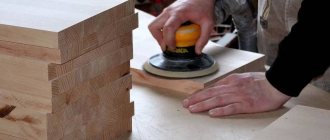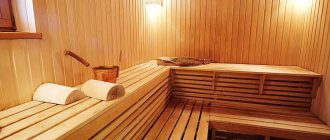Infection with fungus and mold on wooden floors is a common problem faced by home and bathhouse owners.
Spores actively develop in a suitable habitat, so it is impossible to get rid of them using wet cleaning.
To effectively eliminate fungus in the underground, it is necessary to find out the cause of its appearance, remove the formations and, if necessary, replace the floor covering.
Content:
- Causes of fungus
- Types and signs of fungal formations
- How to remove and destroy
- How to destroy fungus step by step
- How to prevent mold from reoccurring
- Video on how to get rid of fungus in the underground of a wooden house
If the eternal struggle between humanity and mold has transferred its battlefield to your wooden house, then there is no time to hesitate.
The first signal that cannot be missed is the appearance of dark green, whitish, gray and black spots, after which particularly sensitive people will notice the smell, and over time it will only intensify. Many people do not attach any importance to the appearance of mold in the house, and even the smell does not bother them. And since the basement is usually characterized by a cool temperature, food is stored there without a twinge of conscience. Although science has already proven that fungus in a wooden house causes allergies and has a destructive effect (even on the space station they encountered its harmful effects).
If there is a fungus in the underground of your wooden house, then in this article we will look at the most effective methods on how to get rid of it.
The impact of spores on human health
Mold is one of the oldest organisms living on the planet. It arose long before the appearance of humanity. Despite such a long period of existence, man was never able to destroy it. Nowadays the appearance of a black-yellow-green spot on the wall will not surprise anyone. Many people don’t even pay attention to it, however, it’s worth considering whether it poses a health hazard.
Recently, biologists have begun to treat mold as a serious problem. They found that daily spending time in the “company” of mold shortens a person’s life. What is dangerous for people is not the mold itself, but its spores, which enter the body through the respiratory tract and pores. They destroy the immune system and affect the internal microflora. As a result, chronic ailments begin to develop: asthma, bronchitis, pulmonary tuberculosis, various allergies and other respiratory diseases.
Mold spores under a microscope.
The higher the air humidity, the more mold spores become, which every day undermine the health of the inhabitants of the house.
Causes of fungus
Mold is not just a coating on the surface; its spores float in the air.
The main factors for the appearance of mold in any home, including a wooden house, are poor room ventilation, dampness and heat (heat for mold is already a temperature range from +4 to +20°C).
It is precisely at these moments that you need to check the house and basement. Since even after removing mold by any of the methods, if nothing changes in the conditions, it will grow again in a fairly short time.
Prevention measures
After the fungus in the cellar has been destroyed, care must be taken to ensure that it does not reappear. Preventive measures will help with this.
- Insulate the building and install waterproofing.
- Make a plan to regularly inspect areas where excess moisture may occur, paying particular attention to corners, joints, and areas where sunlight does not penetrate or occurs very rarely.
- Ventilate the basement and avoid moisture.
- Treat all surfaces, both wood and other materials, with a fungicidal antiseptic.
If you are in the process of building, follow the advice and be careful in advance to prevent fungus from taking up residence in the house.
- A ventilation device will help avoid problems with humidity. If it is impossible to design a supply and exhaust system, at least make windows for ventilation. It’s good if sunlight also penetrates through them.
- Insulate the foundation and waterproof the basement and subfloor.
- Construction materials must be treated with an antiseptic.
- It’s good if the basement has heating.
Types and signs of fungal formations
It's hard to believe, but the mold that can create so many problems is just a single-celled fungus, or rather, an entire colony of single-celled fungus. It is almost always present in the air, but in an inactive state, waiting for its hour, when it becomes sufficiently humid and warm.
The material for mold is absolutely unimportant; it settles absolutely everywhere.
Probably everyone has seen the bluish color of wood - this is also a mold fungus. Bluish mold not only affects the appearance of the wood, but also penetrates inside and creates passages for water. And then it is almost impossible to defeat mold. Subsequently, such a tree will be corroded from the inside, losing not only its beauty, but also its strength.
The boards turn black. This is bad?
The problem is well known and has probably been discussed on the forum. Only the SEARCH for the words “the boards are turning numb” did not yield anything sensible. So I'll try to start a thread with a question: how bad is this?
Edged board 25x100 for lathing under metal tiles and under plastic ceilings. Beam 150x100 for rafters. The material they brought was damp, but all white. In just two or three days, half of the boards began to actively turn black. It's clear it's from moisture. So what should we do with it now? How serious is this? What will happen to this blackness if the board is used in dry conditions? Won't this cause the boards to rot? Maybe there is some remedy?
So this is rot (((What you called “blackening”. Run a search, “compositions that protect wood from rotting” will be found right away..
2 Scorpio No, this is not bad, but very bad. Looks like prussic fungus. Depending on the moisture content of the lumber and the depth of the damage, the blue may appear more intense. They also say that pine turns blue, and larch and spruce turn black. But the latter rarely happens.
maybe it's a fungus
And what? Were the boards not stacked with spacers? NOT ventilated?
but no, in two or three days, at least ventilate it, or not. Obviously the author bought the soaked wood. Screw the product.
If you turn blue, you can’t do anything. You can't bleach it...it's mold. initially a common occurrence for forests in swamps, etc. (i.e. if the board is initially blue).
However, if it’s for sheathing, you can treat it with the appropriate impregnation and install it. It shouldn’t rot, but it won’t be suitable for front finishing.
PS By the way, in stores I saw veneered doors, under the veneer the whole timber is blue and this doesn’t stop the manufacturer, it’s not visible
I completely agree – this is a prussic fungus. Saw material from the spring forest. It was not ventilated or dried to a transport humidity of 15%. Can be treated with antifungal compounds. But perhaps it’s too late. Return it to the seller. or burn it.
What fear. “Lumber that has blue stains—blue stains—or spots of black spot mold is suitable for any structure.” " > (and more)
2 Scorpio You need to look directly. If it is only mold or prussic fungus, then when the boards dry, it will stop developing. True, the color of the boards will not change, the blue will remain, but this will not affect the performance or strength in any way, only the decorative ones. You can try bleaching, I’ve never tried it myself, so I can’t vouch for the results. And this is of no use for sheathing and rafters. It will be necessary to treat with a penetrating antiseptic, for example, green Senezh. But this is worth doing in any case, and not just because of defeat.
For the future, if you buy lumber for future use and will use it over a long period of time, then treat it with a paint or garden sprayer with a special antiseptic for transportation. It is colorless and decomposes over time, but for at least six months it will help prevent blue discoloration. And stack them with spacers to ventilate them and cover the stack from precipitation. Lumber should never be stored in bulk.
How to remove and destroy
There are a lot of means to combat mold. Some are more effective, some are less...
But before you start work, you need to take care of your own protection - glasses, gloves, a respirator. Personal protective equipment will protect you from inhaling mold spores and substances with which you will carry out the treatment.
Antifungal drugs
The product is a real biological weapon - a solution of bacteria that destroys mold but does not harm humans. The effect, however, is not immediate; the effect is noticeable already on the third day. The idea is that “good bacteria” grow and crowd out “bad fungi.” The product is made on the basis of probiotics (made in Belgium). The price is rather high - about 900 rubles.
Solutions for treating wood infected with fungus
It is not difficult to prepare such solutions yourself; most of the components can be found in construction or hardware stores.
Antiseptic primer
Thanks to the polymers contained in the antiseptic primer, moisture is not able to penetrate into the clogged pores of the wood, plus the antiseptic has its effect.
Treatment with such a product during construction or renovation will protect your basement from fungal formations (you won’t have to rack your brains later about how to get rid of fungus in a wooden house). In general, the treatment is not such a complicated process, so it can be carried out independently for the purpose of prevention or after the appearance of mold.
Bleach
The first remedy in terms of frequency of use in the fight against mold. It can be regular bleach, but it must be chlorine based. It is necessary to dilute it with water - 1:10. Before processing, be sure to wear rubber gloves, as chlorine is a very caustic component. After which the affected surface of the room is treated with the prepared solution. It is also worth remembering that bleach vapors are very toxic and can cause poisoning in humans.
Therefore, you need to pay special attention to the flow of fresh air into the room. You can put a fan on the basement window and turn it on, so it will drive air from outside into the room.
Vinegar
Vinegar is good because it is easily accessible and harmless.
It is better to apply it to the affected areas by spraying; for this you can use a spray bottle. First, acetic acid is sprayed onto the mold, and then all these deposits need to be cleaned off. Spray the vinegar generously again and leave for a couple of hours. Afterwards simply wipe with a damp cloth.
Ammonia
You need to work with ammonia in the same way as with vinegar - that is, spray it on the mold. But in its pure form, ammonia will be difficult to use, so you need to mix it with water in a one-to-one ratio.
The treatment must be carried out with increased safety measures, since the caustic vapors of ammonia can lead to dizziness and poisoning. Therefore, you should not forget about organizing the flow of fresh air.
Baking soda
Baking soda, in addition to disarming the fungus itself, will also clear the air of the unpleasant smell of mold.
The baking soda needs to be wet. Then use a damp cloth, dipped in soda, to walk over the infected areas of the wood. Having thus removed the fungal formations, you need to remove the remaining baking soda from the surface and go over again with a damp cloth. Then leave the room to ventilate.
Sodium fluoride
You need to be extremely careful with this drug, as it is very toxic and dangerous to humans, animals and insects. With the abundance of various mold repellents, it is worth considering whether it is necessary to use such a dangerous substance in the home (it is mainly used in logging enterprises to protect logs from bark beetles and blue mold).
Sodium fluoride is poorly soluble in water, so it is used in the form of a paste. Clay is used as an additional substance, which must first be sifted.
For 1 square meter you will need:
- 150 g sodium fluoride
- 135 g clay
- 200 ml water
Apply the paste to damaged areas of wood and leave to dry.
Folk remedies
The effectiveness of folk remedies is lower, and they can only be fought if there is very little mold. Popular and effective ones include:
- Citric acid (1 tbsp per 1 glass of water)
- Tea tree oil, lavender and rosemary (but too expensive to treat a basement)
- Potassium permanganate (1 tsp potassium salt of permanganate acid per 1 liter of water)
- Iodine solution
To combat the odor after the treatment, you can use baking soda and charcoal. They absorb unpleasant odors very well. Baking soda should be applied to areas where there was previously mold. And coal can simply be placed around the room.
Care at home
You can slightly reduce sweating and the discomfort it causes at home.
For this:
- use antiperspirants and powders that absorb excess moisture;
- Maintain good hygiene, take a shower with antibacterial soap at least twice a day;
- change socks and clothes as you get wet;
- limit the consumption of foods with caffeine, hot spices and alcohol, which increase sweating;
- use special anti-sweat insoles for shoes;
- carefully choose socks and shoes for hyperhidrosis of the legs (they should be made of natural materials, breathable, not compress or restrict the movement of the legs).
Home treatment can be supplemented with foot and hand baths made from decoctions of medicinal herbs with an antiseptic and drying effect (chamomile, oak bark, sage, walnut leaves, horsetail).
Hyperhidrosis of the legs causes the most trouble. It causes skin and nail fungus, bacterial infections, irritation, itching, warts, and calluses. Therefore, such feet require special care, regular medical pedicures and examination by a podiatrist to identify these problems at an early stage.
How to destroy fungus step by step
So, having chosen a mold control tactic, the following steps are taken:
- Existing mold must be removed. To do this, you can use soapy water and sandpaper.
- Treat the surface with an antifungal agent.
- Inspect all items, and if mold is found, clean them too. If you can’t clean it (the mold has settled deeply and reliably), then it’s better to throw the thing away.
- The main weapon that will work for the future “future without mold” is to establish good ventilation; you need to organize a constant flow of fresh air.
- Reduce humidity in the basement.
Overview of the antiseptic products market
When folk remedies are useless, heavy artillery enters the battle - highly effective chemical solutions that are used both for prevention (initial treatment) and for “treating” already damaged elements. Let's look at the popular antiseptics that can be found on the shelves of construction supermarkets.
Wood for the external cladding of a house, like all elements of decorative interior design, must be processed without fail, otherwise the risk of damage is very high.
Tikkurila Valti - has excellent protective properties even in difficult atmospheric conditions, contains natural oils, and prevents the formation of mold. Volume 2.7 l – 1500 rub.
Let’s name several manufacturers of antiseptics that are popular and regularly occupy the top lines of the ratings:
Tikkurila. Known for a large range of multi-component impregnations that can protect wood in the most difficult conditions. Pay attention to Valtti Pohjuste deep penetration primer, Vinha covering solution. Tinted impregnation-glaze Valtti Color (Extra, Satin, Primer series) penetrates deep into wood fibers and does not form a film, as a result of which wooden products look natural.
Senezh The most reliable antiseptic is for deep impregnation, ideal for treating facades. It is not washed out by water and is able to protect wood in difficult weather conditions. Senezh Ecobio is designed for use inside the home, and Aquadecor was created specifically for decoration. There are many positive reviews about Senezh protective equipment for saunas and baths.
Belinka. Suitable for processing internal and external wooden surfaces. BELINKA BASE contains a concentrated portion of biocides, BELOCID is suitable for both prevention and treatment of contaminated surfaces
BELINKA IMPREGNANT is a colorless impregnation, good where it is important to preserve the natural texture of the fibers.
Aquatex. Perfectly protects logs, boards, lining, chipboards from mold and wood-boring beetles
Has more than 10 tinted options. The solution is used as a primer or impregnation.
Neomid. A well-known Russian brand with a wide range of antiseptic products. NEOMID 440 ECO effectively protects wood products in rooms with high humidity, NEOMID 400 is used for processing interior parts, NEOMID 46 BiO protects lumber from mold damage.
The list can be continued with the names of alternative products: Dufa Wood Protect, Sitex, Pinotex, Texturol, Woodmaster. When using this or that product, you must act strictly according to the instructions.
How to prevent mold from reoccurring
If mold has taken place, then nothing will prevent it from appearing again. You need to create conditions under which it will be uncomfortable for her to reproduce and live in your house and basement.
- First of all, this is to ensure good and constant ventilation of the room.
- The walls should not be filled with furniture or littered with rubbish. The air should circulate well in the room.
- Check to see if rainwater is getting into the underground and if there are any traces of groundwater.
- If you notice that your neighbors have mold and the buildings are located quite close to your home, then preventive treatment with an antiseptic against mold can be carried out twice a year.
Mold spores are constantly in the air, and we live in friendly neighborhoods with them, but whether we allow mold to break into our space is another matter. The main thing to remember here is that everything is in our hands, the rules for preventing mold are very simple!
Why does mold form under the floor and in the underground of a wooden house?
Fungus appears under the floor for a reason. Causes:
- The difference in temperature between an unheated and/or unheated basement and home causes condensation to accumulate and excessive humidity. And in a humid environment, mold develops.
- Poor ventilation. The fungus feels very comfortable in moldy, still air.
- Lack of antiseptic treatment of the materials from which the subfloor is made. Wooden parts of the structure are especially susceptible to mold and rot.
- The fungus can spread to the walls and floor of the basement from food stored there if it is infected.
Method for removing mold using sulfur
For disinfection, experts recommend using sulfur dioxide vapor (sulfur dioxide). Due to its state of aggregation, sulfur fights mold and mildew in the most inaccessible places. Use this time-tested product as follows:
- Close all ventilation openings and exits.
- Place the sulfur block in a stable metal container.
- Light the checker and quickly leave the room, closing the door behind you.
- Leave the sulfur to act on the fungus for several hours, or better yet, overnight.
- After 10 hours, thoroughly ventilate the treated area.
- After treating the room, whitewash the walls, floor and ceiling with slaked lime.
Effective methods of control
Before you start fighting moisture, you need to determine the reasons for its appearance. All further actions depend on this. The causes can be identified by the location of the moisture.
- If on the ceiling and walls, there are problems with ventilation.
- Available only on walls; vertical waterproofing of walls is required.
- If on the floor, groundwater has increased in volume.
External waterproofing
Check the quality of installation; there may be problems with slopes and drainpipes. Possible breakdowns of the drainage system.
If you don't have any waterproofing installed at all, consider designing it. Later, protect the outer walls from moisture:
- Remove the blind areas.
- Dig 0.5 m from the walls along the entire perimeter.
- Dry the outer walls.
- Lubricate the wall with antifungal mixtures.
- Lubricate the wall with mastic, clay or concrete (one or the other).
- Install blind areas. They are fixed 0.5 m above the ground
- Fill the hole.
The installed moisture insulation system will help remove dampness.
Internal waterproofing device
In addition to the external drainage system, it is necessary to make an internal one, with the help of which the required temperature in the cellar is maintained. Procedure:
- Dry the room.
- Put the walls in order, remove the old whitewash.
- Clean out the cracks.
- Use the antifungal mixture again.
- Cover the walls with waterproofing compound.
Protect your basement from moisture
Your damp basement will no longer be like that, waterproofing will not allow excess moisture to penetrate inside.
Ventilation system
An additional ventilation system will help remove moisture in the basement. It is installed when air exchange is disrupted. There are two types of such ventilation:
- Natural. It uses the so-called. “vents” are openings throughout the room. According to the established norm, their area should correlate with the area of the entire room as 1:400.
- Forced. It is more often used in large rooms. It involves the installation of special equipment. It allows fresh air into the room when necessary.
Forced installation costs a lot.
Preventive measures
The walls will need to be dried before storing food again. It would be a good idea to whitewash the ceiling, paint all surfaces, and treat the boards for shelving. Ventilation and waterproofing must be constantly checked for damage.
Read also: How to become a creative person
Prevention should be carried out annually exclusively in the summer. In this case, the air temperature should be without sudden changes that contribute to the formation of condensation. To avoid new fungal infections, wall waterproofing is always available.
Preparatory work
First you will need to remove structures and supplies. On the street, the tree must be inspected; if there are black spots, this is mold. This means that it is necessary to inspect all structures.
The shelves are laid out in the sun and dried thoroughly. Wood affected by mold must be treated with a solution of copper sulfate, the concentration of which should be no more than 10%.
If you have the funds for a new tree, it is better to replace the entire structure. Perhaps the fungus is inside, but has not yet made its way out. In this case, after treating the room and bringing the wood inside, the mold will continue to multiply.
Whitewashing with lime will help remove moisture from the cellar. This procedure is carried out before draining the basement.
Precautionary measures
When starting to destroy fungus in the basement of a house or cellar, you need to take care of your own safety. Close-fitting glasses, a respirator, a hat and closed clothing will help protect against mold spores when cleaning it from surfaces. When working with chemicals, you must use high rubber gloves to avoid exposure to aggressive substances on your skin.
After applying antifungal drugs, you should immediately leave the room.
